Pediculosis, or "lousiness", is one of the most prevalent communicable conditions in the United States. Head lice infestation is very common and it has been estimated that up to one in every 10 children in school acquires head lice at some time during their years in school. Head lice can infest people of all ages, but children are more prone to infestations due to their play activity and close physical contact. Girls acquire head lice more frequently than boys because of hugging and head-to-head “selfie” image capture habits.
The direct health impacts of head lice feeding on the scalp may be negligible, but inappropriate treatments can pose unnecessary health hazards to children and caregivers. According to the Centers for Disease Control and Prevention (CDC) (2010), an estimated 6 million to 12 million infestations occur each year in the U.S. among children 3 to 11 years of age (http://www.cdc.gov/parasites/lice/head/gen_info/faqs.html). The economic impact of head lice in the U.S. is estimated at $1 billion dollars annually, which includes direct costs (treatments and tools used to manage lice and nits) and indirect costs (missed school and work days, misdiagnosis, misuse of pediculicides, and unnecessary expenditures) (Hansen and O’Haver 2004).

Because of the occurrence of pesticide resistance, it is more important than ever to use an integrated pest management (IPM) strategy to battle this “lousy” pest. Using multiple complementary control tactics and paying careful attention to results is critical. Relying on a one-step / one-tactic “fix” generally has little chance of success. Parents, teachers, and childcare professionals should be aware of this insect pest and know how to prevent and manage it.
Lice eggs are called nits. Nits are oval in shape. They are very small, about the size of a knot in thread, and are often camouflaged with the host’s own hair pigment. They are usually glued to hairs by female lice on the head near the scalp (Fig. 4). Nits are quite often found on hair around a person’s ears and back of the head. Eggs will hatch in 7 - 10 days under room temperature. Once a nit hatches, a nymph (immature) leaves the shell casing that then turns white in color. The empty nits are far more obvious to the observer and unless physically removed they can remain attached to the hair and eventually grow out over time.
Both nymphs (immatures) and adults (Fig. 1C) have piercing-sucking mouthparts to pierce the skin for a blood meal. Within an hour of hatching, a nymph will take its first blood meal. Lice pass through three nymphal stages during the next 10 - 12 days before reaching the adult stage (1/8 inch or 2-3 mm long). The female louse can mate and begin to lay eggs soon after becoming an adult. Females can live up to 40 days, laying 3 - 7 eggs per day, up to 50 - 100 eggs during their lifetime! A new generation of head lice can occur every 3 weeks.
The reaction of individuals to louse bites can vary considerably. Most often, people previously unexposed to lice may experience little irritation from their first bites. But many individuals become sensitized to the lice saliva that is injected when they feed, and itching is a common reaction to the constant biting. Reactions include reddening of the skin, itching, and overall inflammation. Broken skin due to constant scratching may lead to further complications and secondary infections so catching infestations early is important.
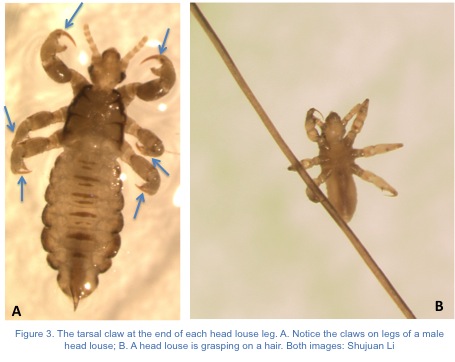
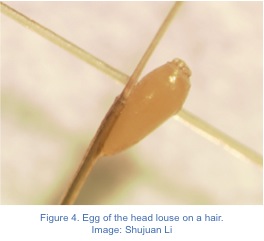
Periodic inspections for early detection of individual lice are far easier than dealing with advanced infestations (Fig. 5). In fact, the problem of head lice can be so rampant among preschool and school-aged students that schools must often work in conjunction with many families to control an infestation. During the early fall months (August to November), children should be inspected weekly by parents or caregivers. Follow these steps to inspect for head lice:
Remove lice and nits from the household environment. Once an infestation is detected, all clothes worn by an infected person should be laundered or dry-cleaned. Towels, pillowcases, sheets, blankets and other bedding should be washed and placed in the clothes dryer until completely dry. The dryer heat will kill the lice and nits. Any non-washable items should be dry cleaned or sealed in a plastic bag and placed in the freezer at 5 °F or lower over-night (this is a good option for headphones and other non-washable items). Vacuuming the home will remove shed hair that may have nits attached. Remember that lice removed from the body for 48 hours will die, so simply placing things that cannot be laundered (very large stuffed animals, duvets, furniture, etc.) in a plastic bag or “off-limits” for 48 hours will help to eliminate lice. Homes, school or childcare classrooms need not be treated for head lice.
Only initiate a head lice treatment when there is a clear diagnosis or identification of living adult or immature lice present. Parents, childcare professionals, caretakers and pediatricians should use products or methods that are effective, and most importantly, safe.
OVER-THE-COUNTER LICE SHAMPOOS
Many over-the-counter lice shampoo products (pediculicides) sold in pharmacies and supermarkets contain insecticides, and if they are not used exactly according to the label directions they can be hazardous (Fig. 6). When using a pediculicide shampoo, minimize body exposure by confining the product to the head hair. Wash the infested person's hair in a basin or sink so the insecticide does not contact other parts of the body. Never apply treatments to children in the bath or shower!
The person helping to apply the treatment should wear chemical resistant gloves. Never apply an insecticide to anyone who has open cuts, scratches, or inflammations, and never use these materials on infants. Consult a doctor if you have an infested infant. Always read and follow label directions completely and carefully.
As previously discussed, widespread resistance has developed by head lice to the most commonly used over-the-counter pediculicides (pyrethrins and permethrin). If a pediculicide is effective, lice should die within 30 minutes of a treatment. If live lice are found after 30 minutes, discontinue use of that product. Switch to a different kind of product that does not contain the same active ingredient (Fig. 7).
Pediculicidal products are for external use only, and should only be applied to the scalp. These products may be harmful if swallowed or inhaled. If accidental ingestion occurs, contact poison control immediately at (800) 222-1222 (Fig. 8).

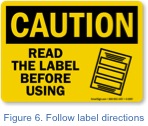
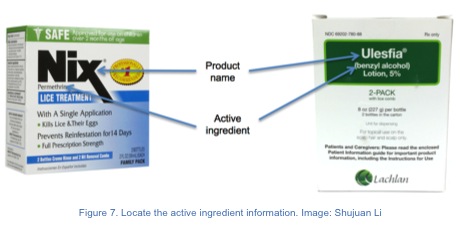

PRESCRIPTION LICE TREATMENT OPTIONS
Two relatively new prescription pediculicides that contain different active ingredients are available. Very effective prescription products are Ulesfia® (benzyl alcohol), and NatrobaTM(spinosad insecticide plus benzyl alcohol). Be informed before you visit your pediatrician, avoid high risk and poorly performing control options.
Ulesfia® (benzyl alcohol) Lotion is a Food and Drug Administration (FDA) approved prescription head lice treatment which is not neurotoxic, but it is a highly effective lotion used for the topical treatment of head lice on patients older than 6 months (it should not be used on new borne babies or infants below the age of 6 months). Ulesfia® Lotion is not ovicidal (does not kill lice eggs), so two treatments are necessary. This effective product is available by prescription-only and no resistance issues have been reported. A minimal side-effect most commonly occurring is mild drying of the scalp.
NatrobaTM Topical Suspension (spinosad 0.9% plus benzyl alcohol) is a FDA approved prescription head lice treatment that does not require nit combing and in clinical trials demonstrated superior efficacy to Nix® (permethrin 1%). Natroba™ Topical Suspension contains benzyl alcohol and is not recommended for use on new borne babies and infants below the age of 6 months. Systemic exposure to benzyl alcohol has been associated with serious adverse reactions and death in neonates and low birth-weight infants.
Sklice Lotion (ivermection 0.5%) is a prescription medication for topical use on the hair and scalp only. It is FDA approved as a 10-minute head lice treatment in people 6 months of age and older. To prevent accidental ingestion, adult supervision is required for pediatric application. Avoid contact with eyes.
Some FDA approved prescription treatments are significantly more hazardous than others e.g., products that contain the insecticide, malathion and lindane have more health risks associated with their use. Both active ingredients rely on older pesticide chemistry, and may not be as safe or as effective as the newer prescription treatments previously listed.
In general, most head lice treatment products have limited ovicidal activity so two treatments are commonly needed. Skipping the second treatment often leads to re-establishment of head lice, thus necessitating an additional two treatments. The second treatment is required to kill lice that hatch after the first treatment. Typically, the second treatment should follow 7 - 10 days after the first, depending on the product and its instructions. Do not be tempted to repeat treatments sooner than recommended. Follow instructions for the correct timing of the second treatment. Do not expose children to more treatments than necessary as health hazards increase.
ALTERNATIVE APPROACHES
In addition to pediculicide treatments, alternative approaches with other products include using petroleum jelly, mayonnaise, margarine, herbal oils, enzyme-based products and olive oil. There has been no conclusive evidence showing that these treatments are effective. But, any time that the hair and scalp are shampooed, some head lice are eliminated in the process.
Suffocants – petroleum jelly, mayonnaise, olive oil, or Cetaphil Gentle Skin Cleanser
Suffocants smother adult lice and to some extent nits by preventing air exchange. These products are massaged on to the entire scalp and hair then covered with a shower cap, and left on for several hours. Usually, the process is followed by nit combing.
Diligent shampooing is usually necessary for at least the next 7 days to remove the residue of suffocants. The combination treatment of applying a suffocant, followed by shampooing, combing and drying can be beneficial in removing lice and nits.
Another alternative approach without the sticky residues is to use soap shampoos that contain coconut or olive oils. Begin with daily shampooing and use of a hair conditioner. Shampoo with 1% coal tar can help to reduce an irritated and itchy scalp and reduce dandruff (which can be mistaken for lice). Hair conditioners (e.g., Fekkai hair conditioners) help with the nit combing process greatly. Each successive shampooing and conditioning eliminates some lice and nits.
Cetaphil Gentle Skin Cleanser can be massaged on to the entire scalp and hair. Comb out any excess product, then dry the hair completely with a hair dryer, and leave the dried product on the hair for 8 hours. The hair can then be washed and the process should be repeated several times over the next couple of weeks. Research (Pearlman 2004) has demonstrated a high success rate of greater than 94% lice reduction even without nit combing. If nit combing is for some reason impossible, this may be a good treatment choice.
Enzymes - LiceLogic, Lice B Gone, Lice R Gone
Treatment products containing enzymes dissolve or soften the glue that attaches the nit to the hair shaft, promoting nit removal during combing. Some head lice may also be eliminated by the treatment.
Desiccation (heat treatment) – AirAllé™ (formerly known as LouseBuster™) and hair dryer
The AirAllé™ (formerly known as LouseBuster™) is a machine that uses hot air to desiccate lice and eggs (Fig. 9). Research showed that the heat treatment caused high mortality of eggs and hatched lice (Bush et al. 2011). The device is used primarily by professionals in schools, clinics, and places where head lice are commonly treated.
A home hair dryer may not be as effective as the AirAllé™; however, hair drying will desiccate some lice and nits each time it is used. A hair dryer on warm heat setting and hair-brushing or combing are effective ways of eliminating lice mechanically.
Manual removal
An IPM strategy that uses multiple tactics is critical to controlling head lice because 20 to 30% of the lice can still be alive after shampoo treatments. Lice survival can be much higher if pesticide resistant lice are on the scalp and hair. Nits, especially those within a 1/2- inch of the scalp, should be removed manually after treatment with any product. Manual removal of nits can be difficult and tedious, but it will help to diminish the social stigma and isolation a child can experience in school, enhance the relationship between a parent and child, and decrease diagnostic confusion.
Special combs are needed and can be effective for nit removal when used diligently each day. It is recommended that frequent combing continue for 10-14 days. Nit combs (Fig. 10) come in many forms and all are helpful to remove nits. The LiceMeister® or Nit Free Terminator combs are effective choices. Some useful tips follow.
The thickness and curliness of the hair of the infected child and the experience of the caregivers may determine the length of time required to comb out lice and nits. A set of effective tools is shown in Fig. 11. To remove head lice and nits from the head use the following steps:
Daily head checks and nit removal are advisable until the infestation is gone. Follow with weekly head checks for the whole family to detect any reestablishing lice.
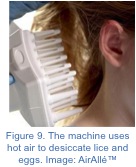
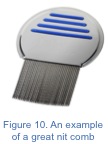
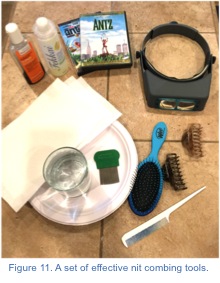
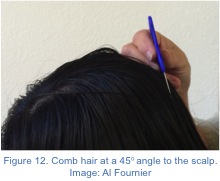
When parents of elementary school-aged children are surveyed as to what childhood health issues concern them most, head lice usually rank higher than more serious conditions (http://www.health.mo.gov/living/families/schoolhealth/pdf/HEADLICE.pdf). In reality head lice can be easily taken care of if you use effective strategies and take the right management steps.
Three things everyone should know
Currently, many school districts have “no nit” policies that exclude students from school because of the presence of nits whether or not live lice are present. Such a policy has not been supported by research and is not recommended by experts, because:
“No nit” policies contribute greatly to the social stigma of lice infestations and have absolutely no impact on preventing additional infestations in the community.
Schools are advised to create a lice management plan and promote an IPM strategy to battle this pest. Screening for nits alone is not an accurate way of predicting which children will become infested. Children having 5 nits or more within 1 cm2 of the scalp are significantly more likely to develop an infestation, but even then only 1/3 of these higher-risk children convert to having an active infestation. Providing information to families on the diagnosis, treatment, and prevention of head lice is a helpful and useful plan. Parents and guardians should be encouraged to check their children’s heads for lice if the child is symptomatic.
Important Do’s:
Important Do not’s
In Summary, implement an IPM strategy:
Product names mentioned are registered trademarks. Any products, services, or organizations that are mentioned, shown, or indirectly implied in this publication do not imply endorsement by The University of Arizona.
References
Bush, S.E., Rock, A.N., Jones, S.L., Malenke, J.R. and Clayton, D.H. 2011. Efficacy of the LouseBuster, a New Medical Device for Treating Head Lice (Anoplura: Pediculidae). Journal of Medical Entomology. 48(1): 67-72.
Centers for Disease Control and Prevention. 2010. Head lice information for schools. Retrieved from http://www.cdc.gov/parasites/lice/head/index.html
Devore, C.D., et al. 2015. Head lice. Pediatrics 2015 May 1; 135:e1355. (http://dx.doi.org/10.1542/peds.2015-0746) - See more at: http://www.jwatch.org/na37715/2015/05/01/get-your-head-game-revised-head-lice-clinical-review?variant=full-text#sthash.8m0rct2o.dpuf
Hansen, R.C. and O’Haver, J. 2004. Economic Considerations Associated with Pediculus humanus capitis Infestation. Clinical Pediatrics, 43 (6): 523-527.
National Association of School Nurses. Position statement: pediculosis in the school community. Silver Spring, MD: National Association of School Nurses; 1999 (Revised 2011). Available at: www.nasn.org/Portals/0/positions/2011pspediculosis.pdf. Accessed September 3, 2014
Pearlman, D.L. 2004. A simple treatment for head lice: Dry-on, suffocation-based pediculicide, Pediatrics, 114 (3): 275-279.
Yoon, K.S., Clark, J.M., et al. 2015. Lice in at least 25 states show resistance to common treatments. Presented at American Chemical Society. http://www.smithsonianmag.com/science-nature/lice-can-resist-drugs-have-infested-half-states-us-180956308/?no-ist; Press conferences from #ACSBoston by American Chemical Society: https://www.youtube.com/watch?v=l-YIQCYE8uo&index=11&list=PLLG7h7fPoH8I0bHbe9mnjum8w_hlEXQnH
Resources
More information regarding head lice management:
Head Lice http://pediatrics.aappublications.org/content/135/5/e1355.full.pdf
Head Lice (Sep. 2005) http://cals.arizona.edu/urbanipm/pest_press/index.html
The National Pediculosis Association,® Inc.: http://www.headlice.org/
IPM Action Plan for Head Lice http://www.extension.org/pages/20989/school-ipm-action-plan-for-head-lice#.Uh4-YBYSMy5
Head Lice Pest Press http://cals.arizona.edu/apmc/westernschoolIPM.html#newsletter
Acknowledgements
We thank Dr. James Hagler and Dr. Dale Spurgeon with USDA ARS ALARC for providing the microscope to photograph head lice for this publication. We thank Virginia Barkley for technical assistance. This material is based upon work that is supported in part by the National Institute of Food and Agriculture, U.S. Department of Agriculture (USDA NIFA), Extension Implementation Program, under Award Number 2014-70006-22488. Any opinions, findings, conclusions, or recommendations expressed in this publication are those of the authors and do not necessarily reflect the view of the U.S. Department of Agriculture. Additional support is provided by the U.S. Environmental Protection Agency (EPA) and the University of Arizona – Arizona Pest Management Center (APMC).
Authors
Shujuan (Lucy) Li
Assistant in Extension, Public Health IPM, Maricopa Agricultural Center
Dawn H. Gouge
Associate Specialist and Associate Professor - Urban Entomology
Shaku Nair
Assistant in Extension, Community IPM, Maricopa Agricultural Center
Al Fournier
Associate Specialist in Entomology, IPM Evaluation, Maricopa Agricultural Center
Mike Wierda
Assistant in Extension, Pesticide Safety, Maricopa Agricultural Center
Contact:
Shujuan (Lucy) Li